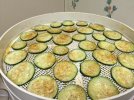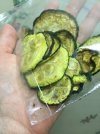Recipe from the Health and Wellness Show of 04 May 2015 (The Mood Cure) (slightly edited)
Cashew Butter Bread
I made a couple of times this week the cashew butter bread and it was very good.
Ingredients:
- 1 cup cashew butter
- 5 large eggs
- 1 tablespoon apple cider vinegar
- 1 teaspoon sweetener like stevia or xylitol
- 3/4 teaspoon baking soda
- 1/4 teaspoon sea salt
Equipment:
Mixer, bread pan or cookie sheet, knife
Baking time
45 minutes baking time
Method:
Pulse the cashew butter and the eggs together, then mix in the vinegar, then the sweetener, baking soda and salt and mix that in. You end up a batter.
Bake at 350°F (175° Celsius) for 45 minutes and let it cool for a while.
I found that cooling for about an hour, even a little bit less, was fine. I made this in a bread pan so it came out like a traditional kind of bread loaf but you could take a cookie sheet and spread it out and make a thinner version of this in which case you could cut that up into very small segments. I like this idea because this also results in ultimately less carb content per serving. We figured out that roughly each slice of this bread has 7 or 8 grams of carbs. So you can have a few and you're not going to hurt even if you're on the keto diet, if you're staying below 25 grams of carbs a day you can still stay within that and have one or two slices of this. I imagine it would go down to 2-3 grams of carbs per chunk if you cut them into 3'x1" pieces (ca. 7,5cm x 2,5cm).
One slice: 7-8 g Carbs
Cashew Butter Bread
I made a couple of times this week the cashew butter bread and it was very good.
Ingredients:
- 1 cup cashew butter
- 5 large eggs
- 1 tablespoon apple cider vinegar
- 1 teaspoon sweetener like stevia or xylitol
- 3/4 teaspoon baking soda
- 1/4 teaspoon sea salt
Equipment:
Mixer, bread pan or cookie sheet, knife
Baking time
45 minutes baking time
Method:
Pulse the cashew butter and the eggs together, then mix in the vinegar, then the sweetener, baking soda and salt and mix that in. You end up a batter.
Bake at 350°F (175° Celsius) for 45 minutes and let it cool for a while.
I found that cooling for about an hour, even a little bit less, was fine. I made this in a bread pan so it came out like a traditional kind of bread loaf but you could take a cookie sheet and spread it out and make a thinner version of this in which case you could cut that up into very small segments. I like this idea because this also results in ultimately less carb content per serving. We figured out that roughly each slice of this bread has 7 or 8 grams of carbs. So you can have a few and you're not going to hurt even if you're on the keto diet, if you're staying below 25 grams of carbs a day you can still stay within that and have one or two slices of this. I imagine it would go down to 2-3 grams of carbs per chunk if you cut them into 3'x1" pieces (ca. 7,5cm x 2,5cm).
One slice: 7-8 g Carbs




